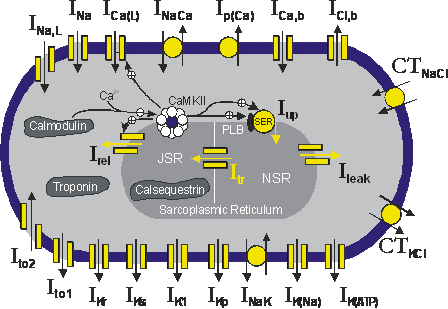Models and Simulations > Ion Channels | Cardiac Cells | Cardiac Tissue
The Hund-Rudy Dynamic (HRd) Model of the Canine Ventricular Myocyte

Hund TJ, Rudy Y. “Rate dependence and regulation of action potential and calcium transient in a canine cardiac ventricular cell model.” Circulation. 2004 Nov 16;110(20):4008-74.
The Hund-Rudy dynamic (HRd) model is based on data from the canine epicardial ventricular myocyte. Rate-dependent phenomena associated with ion channel kinetics, action potential properties and Ca2+ handling are simulated by the model. Distinguishing features of the HRd include (1) regulation of Ca2+-handling by Ca2+/calmodulin dependent protein kinase (CaMKII), (2) incorporation of the late Na+ current (INaL) and Ca2+ dependent transient outward current (Ito2, in addition to Ito1), (3) dynamic intracellular Cl– handling and (4) a novel formulation of calcium release from the junctional sarcoplasmic reticulum (JSR). Interaction between dihydropyridine receptors (ICaL) and ryanodine receptors (RyR) occurs in a restricted Ca2+ subspace. The calcium release formulation incorporates activation of RyR by ICaL, Ca2+-dependent inactivation of RyR, and modulation of RyR open-probability by both JSR and subspace Ca2+.
ERRATUM:
In the online supplement for the HRD code, there is a typo in the formulation of the Na+ current rate constant . The equation should read:

SIMULATION NOTES: